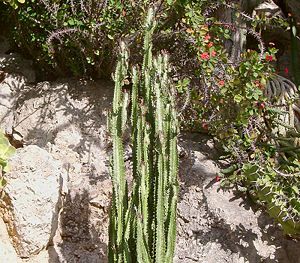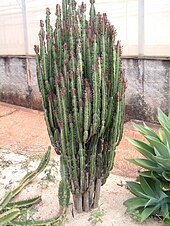Triangular milkweed
| Triangular milkweed | ||||||||||||
|---|---|---|---|---|---|---|---|---|---|---|---|---|

Triangular Spurge ( Euphorbia trigona ) |
||||||||||||
| Systematics | ||||||||||||
|
||||||||||||
| Scientific name | ||||||||||||
| Euphorbia trigona | ||||||||||||
| Mill. |
The triangular milkweed ( Euphorbia trigona , Syn .: Euphorbia hermentiana Lem. ) Is a species of the genus Wolfsmilch ( Euphorbia ) from the family of the milkweed family (Euphorbiaceae). The botanical and the German name refer to the always triangular branches of the species.
Description and distribution
The triangular milkweed is a succulent , compact shrub or tree that reaches heights of up to 1.8 meters. Its branches are strictly upright, triangular and kept close to the trunk. They have a diameter of 4 to 6 cm, are (indistinctly) constricted into segments of 10 to 25 cm, which result from the annual (!) Growth and show a light green pattern on a dark green background. On the slightly winged edges of the branches, at a distance of about 1 cm, initially reddish, later dark, 5 mm long shields sit. These have a pair of thorns about 5 mm long that represent transformed stipules .
The lanceolate leaves are often barely 1 cm long and short-lived at the beginning of the growing season , later mostly 3 to 5 cm long. They usually last a few months, in exceptional cases (no direct sunlight) even several years. Side shoots arise on the edges from a barely visible bud between the thorns. Usually, a large number of side shoots initially appear in a narrow area, most of which remain small but wait and see, but can be reactivated by the plant at any time. From a size of about 1 m or a larger number of side shoots, the plant also lignifies externally in the lower area.
The number of chromosomes is 2n = 22.
The cultivated form Euphorbia trigona fa, which is often found in trade . rubra , branches and leaves are more or less red in color.
Flowers never appear.
This species is common in tropical areas of Asia and Africa , but is only known in culture . During centuries of use as a hedge plant , only the most vigorous and densely growing plants were propagated by cuttings . Since no value was placed on the "useless" flowers in this selection, all triangular milkweed plants are now unable to flower.
cultivation
The triangular milkweed is a widespread and popular houseplant . The reason for their widespread use in culture is, in addition to their attractiveness, primarily their ability to persevere long and inconspicuously even under poor conditions. So she often accepts very unfavorable care circumstances for years without any visible signs of suffering for laypeople.
Like all succulent euphorbias, the triangular milkweed also needs a lot of light , warmth , a well-drained soil and an adequate supply of water and nutrients .
Triangular milkweed as a poisonous plant
The milky sap causes irritation to the skin and mucous membranes. This is attributed to a number of toxic diterpenes which, like many ingenol derivatives, can be found in numerous representatives of the genus milkweed. A well-known example is ingenol mebutate . Some of the ingredients have weak carcinogenic potential.
Possible confusion
Because of its cactus-like appearance, the triangular milkweed is often mistaken for a cactus . However, there are reliable criteria by which milkweed plants (euphorbias) can be distinguished from cacti.
- Thorns on shields are only found in (a large group of) euphorbias. In the case of cacti, on the other hand, the thorns always come from felt pads called areoles .
- Paired thorns, as they are typical of (a large group of) euphorbias, never occur in cacti. Conversely, the tufts of thorns typical of cacti are never found in euphorbias.
- The milky sap typical of euphorbias occurs in cacti only in a very small number of plants, namely a few mammillaries . However, these are always spherical to short cylindrical and densely covered by thorny warts, so they cannot actually be confused.
The main difference between euphorbias and cacti, namely the completely different flower structure, cannot be observed due to the inability of the triangular milkweed to flower.
Euphorbia lactea Haw. is also triangular, has a similar pattern on the branches and does not bloom either. It differs, however, through slightly splayed and less strongly winged branches, a lighter body color and only 3 mm large, circular leaves.
Euphorbia triangularis Desf. ex A. Berger is oftenconfusedwith Euphorbia trigona because of the similar sounding name. However, it differs through clearly splayed, three to five-sided branches that do not have a pattern.
literature
- Philip Miller: The gardeners dictionary. Volume 3, 8th edition, J. + F. Rivington, London 1768 ( full text online ).
- Daryl Koutnik: Euphorbia trigona Miller ... or is it? E. hermentiana Lemaire? In: The Euphorbia Journal. Volume 7, Strawberry Press, 1991, ISBN 978-0-912647-08-1 , pp. 11-14.
- Volker Buddensiek: Succulent Euphorbias. Ulmer, Stuttgart 1998, ISBN 3-8001-6634-8 .
Individual evidence
- ↑ Euphorbia trigona at Tropicos.org. In: IPCN Chromosome Reports . Missouri Botanical Garden, St. Louis
- ↑ a b L. J. Lin, GT Marshall, AD Kinghorn: The dermatitis-producing constituents of Euphorbia hermentiana latex. In: Journal of Natural Products . Volume 46, Number 5, 1983 Sep-Oct, ISSN 0163-3864 , pp. 723-731, PMID 6655474 .
- ^ HJ Opferkuch, E. Hecker: On the active principles of the spurge family (Euphorbiaceae). IV. Skin irritant and tumor promoting diterpene esters from Euphorbia ingens E. Mey. In: Journal of Cancer Research and Clinical Oncology . Volume 103, Number 3, 1982, ISSN 0171-5216 , pp. 255-268, PMID 7118989 .




